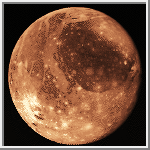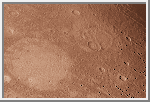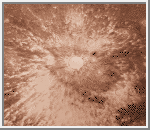 Ganymede
Ganymede Ganymede
GanymedeJupiter III


Ganymede [GAN-ee-meed] is the largest moon of Jupiter and is the largest in our solar system with a diameter of 5,262 km (3,280 miles). Like Callisto, Ganymede is most likely composed of a rocky core with a water/ice mantle and a crust of rock and ice. It has no known atmosphere. It has mountains, valleys, craters and lava flows. Ganymede is mottled by both light and dark regions. It is heavily cratered especially in the dark regions implying ancient origin. The bright regions show a different kind of terrain - one which is grooved with ridges and troughs. These features form complex patterns and have a vertical relief of a few hundred meters and run for thousands of kilometers. The grooved features were apparently formed more recently than the dark cratered area perhaps by tension from global tectonic processes. The real reason is unknown; however, local crust spreading does appear to have taken place causing the crust to shear and separate.

Discovered by ................ Simon Marius & Galileo Galilei Date of discovery ...................................... 1610 Mass (kg) .......................................... 1.48e+23 Mass (Earth = 1) ................................. 2.4766e-02 Equatorial radius (km) ................................ 2,631 Equatorial radius (Earth = 1) .................... 4.1251e-01 Mean density (gm/cm^3) ................................. 1.94 Mean distance from Jupiter (km) ................... 1,070,000 Rotational period (days) ........................... 7.154553 Orbital period (days) .............................. 7.154553 Mean orbital velocity (km/sec) ........................ 10.88 Orbital eccentricity .................................. 0.002 Orbital inclination ................................... 0.195° Escape velocity (km/sec) ............................... 2.74 Visual geometric albedo ................................ 0.42 Magnitude (Vo) ......................................... 4.61

 Animation of Ganymede
Animation of Ganymede
 Ganymede
(GIF, 187K)
Ganymede
(GIF, 187K)
This shows an entire hemisphere of Ganymede. The prominent dark region,
called Galileo Regio, is about 3,200 km in diameter. The bright spots are
relative recent impact craters. Part of the Galileo Regio may be covered
with a bright frost.
(Credit: Calvin J. Hamilton, and NASA)
 Southern Galileo Regio
(GIF, 400K)
Southern Galileo Regio
(GIF, 400K)
This image of southern Galileo Regio shows impact craters in various
stages of degradation. Almost all of the craters appear flat. The
two prominent light colored craters are almost completely erased by the
flow in the icy crust.
(Credit: Calvin J. Hamilton, and NASA)
 Impact Crater
(GIF, 434K;
GIF, 2M)
Impact Crater
(GIF, 434K;
GIF, 2M)
This mosaic of high resolution images on Ganymede shows a relative
fresh impact basin surrounded by ejecta.
(Credit: Calvin J. Hamilton, and NASA)

